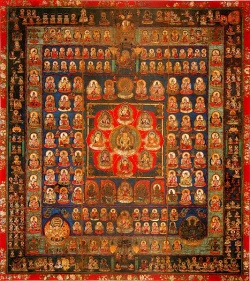Difference between revisions of "Mandala of the Two Realms"
(Created page with "thumb|250px| The Mandala of the Two Realms (Jp. 両界曼荼羅 Ryōkai mandara), also known as the Mandala of the Two Divisions (Jp. ...") |
|||
| Line 2: | Line 2: | ||
The [[Mandala of the Two Realms]] (Jp. [[両界曼荼羅]] [[Ryōkai mandara]]), also known as the [[Mandala of the Two Divisions]] (Jp. [[両部曼荼羅]] [[Ryōbu mandara]]), is a set of two [[mandalas]] depicting both the [[Five Wisdom Buddhas]] of the [[Diamond Realm]] as well as the [[Five Wisdom Kings]] of the [[Womb Realm]]. The number of [[deities]] arranged around the cores varies, but may range as high as 414. | The [[Mandala of the Two Realms]] (Jp. [[両界曼荼羅]] [[Ryōkai mandara]]), also known as the [[Mandala of the Two Divisions]] (Jp. [[両部曼荼羅]] [[Ryōbu mandara]]), is a set of two [[mandalas]] depicting both the [[Five Wisdom Buddhas]] of the [[Diamond Realm]] as well as the [[Five Wisdom Kings]] of the [[Womb Realm]]. The number of [[deities]] arranged around the cores varies, but may range as high as 414. | ||
| − | The [[Diamond Realm]] represents the unchanging cosmic principle of the [[Buddha]], while the [[Womb Realm]] depicts the active, [[physical]] [[manifestation]] of [[Buddha]] in the natural [[world]]. The [[mandalas]] are thus considered a compact expression of the entirety of the [[Dharma]] in [[Mahayana]] [[Buddhism]], and form the root of the [[Vajrayana]] teachings. {{Wiki|Japanese}} [[Shingon]] [[temples]], in particular, often prominently display the [[Mandalas]] of the [[Two Realms]] mounted at right angles to the image platform on the central [[altar]]. | + | The [[Diamond Realm]] represents the [[unchanging]] [[cosmic principle]] of the [[Buddha]], while the [[Womb Realm]] depicts the active, [[physical]] [[manifestation]] of [[Buddha]] in the natural [[world]]. The [[mandalas]] are thus considered a compact expression of the entirety of the [[Dharma]] in [[Mahayana]] [[Buddhism]], and [[form]] the [[root]] of the [[Vajrayana]] teachings. {{Wiki|Japanese}} [[Shingon]] [[temples]], in particular, often prominently display the [[Mandalas]] of the [[Two Realms]] mounted at right angles to the image platform on the central [[altar]]. |
| − | The two [[mandalas]] are believed to have evolved separately in {{Wiki|India}}, and were joined together for the first time in {{Wiki|China}}, perhaps by [[Kukai]]'s teacher [[Huiguo]] . | + | The two [[mandalas]] are believed to have evolved separately in {{Wiki|India}}, and were joined together for the first time in {{Wiki|China}}, perhaps by [[Kukai]]'s [[teacher]] [[Huiguo]] . |
{{R}} | {{R}} | ||
[http://projectionwww.physicsdaily.com/physics/Mandala_of_the_Two_Realms projectionwww.physicsdaily.com] | [http://projectionwww.physicsdaily.com/physics/Mandala_of_the_Two_Realms projectionwww.physicsdaily.com] | ||
Revision as of 17:11, 18 April 2015
The Mandala of the Two Realms (Jp. 両界曼荼羅 Ryōkai mandara), also known as the Mandala of the Two Divisions (Jp. 両部曼荼羅 Ryōbu mandara), is a set of two mandalas depicting both the Five Wisdom Buddhas of the Diamond Realm as well as the Five Wisdom Kings of the Womb Realm. The number of deities arranged around the cores varies, but may range as high as 414.
The Diamond Realm represents the unchanging cosmic principle of the Buddha, while the Womb Realm depicts the active, physical manifestation of Buddha in the natural world. The mandalas are thus considered a compact expression of the entirety of the Dharma in Mahayana Buddhism, and form the root of the Vajrayana teachings. Japanese Shingon temples, in particular, often prominently display the Mandalas of the Two Realms mounted at right angles to the image platform on the central altar.
The two mandalas are believed to have evolved separately in India, and were joined together for the first time in China, perhaps by Kukai's teacher Huiguo .
